How to care for child refugees: lessons from Nordic countries

The Nordic countries of Denmark, Finland, Sweden, Iceland and Norway accepted 45,765 unaccompanied minors [pdf] in the peak year of the refugee crisis, 2015, compared with the EU’s total of 88,250. This has set their migration and social care agencies an unprecedented test.
“We didn’t have the systems in place for so many, and then there were quick changes in the legislation,” says Anna Gärdegård, project leader at the Nordic Welfare Centre and the author of a new report comparing the Nordic countries’ reception of minors. However, it is also forcing them to develop strategies from which UK authorities can learn.
Andrew Ireland, corporate director of social care, health and wellbeing at Kent county council, says Britain has decided to follow a model similar to Sweden’s.
Rather than the county where the child asylum seekers arrive being responsible for handling both their reception and their long-term care, that county arranges for unaccompanied minors to be transferred elsewhere in the country. “The position now is that when young people come in, they become our responsibility in exactly the same way, but there’s a national transfer scheme, so we are functioning as the reception point,” Ireland says.
However, Gärdegård’s report, Society’s Reception of Unaccompanied Minors in the Nordics, highlights some problems with this transfer approach: in Åsele municipality in remote northern Sweden, for instance, one in 10 schoolchildren are unaccompanied minors.
But making the children the responsibility of council social services departments rather than – as is the case in Finland and Denmark – the immigration authorities is still a better solution, she believes.
Gärdegård also praises the way schools in Norway have worked to place unaccompanied minors in normal school classes with Norwegian pupils to help integration, supplementing these classes with extra lessons and language support.
“We know from research and evidence how important school is,” she says. “If they manage to get through school, a lot of other future social problems will be lower.”
Other positive measures taken in Nordic countries include making films to help new arrivals and giving each of them a legal representative.
In Kent, children below the statutory school age of 16 are sent to mainstream schools and given additional support but, says Ireland, the county needs to do more to connect child migrants to the community. “What matters to us is anything relating to community cohesion because these are young people who are going to be resident in local communities.”

 Yahoo News
Yahoo News 
